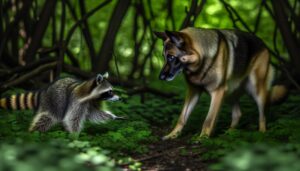Can a Rooster Kill a Raccoon to Defend Your Coop?
A rooster is unlikely to kill a raccoon due to stark differences in physical capabilities. While roosters have sharp spurs and an aggressive demeanor, raccoons possess superior strength, agility, and problem-solving skills.
Raccoons use their claws and powerful bite to overpower small animals. Despite a rooster's territorial nature and defensive actions, it lacks the resilience to withstand a raccoon's predatory assault.
The probability of a rooster emerging victorious in such an encounter is minimal. Understanding these dynamics and employing effective safety measures for poultry enclosures can provide valuable insights into safeguarding backyard flocks against nocturnal predators.

Key Takeaways
- Roosters' defensive spurs are insufficient against raccoons' superior size and strength.
- Raccoons' powerful claws and bite make them a formidable threat to roosters.
- Roosters' aggressive nature does not counteract raccoons' lethal predatory skills.
- Encounters typically result in raccoons emerging victorious due to physical advantages.
- Roosters lack the resilience and power needed to kill a raccoon.
Rooster's Defensive Traits
Possessing sharp spurs and an assertive demeanor, roosters exhibit several defensive traits that equip them to protect themselves and their flock. Anatomically, roosters are endowed with keratinous spurs on their legs, which serve as formidable weapons in close combat. These spurs can inflict painful and potentially injurious puncture wounds on predators.
Behaviorally, roosters are known for their vigilant and territorial nature. They often engage in aggressive posturing and vocal alarms to deter potential threats. Their acute visual and auditory senses enable them to detect intruders swiftly. Additionally, roosters employ a hierarchical social structure within the flock, often patrolling the perimeter to guarantee safety.
Collectively, these traits underscore the rooster's role as a primary defender in avian social systems.
Raccoon's Predatory Behavior
Raccoons exhibit a range of predatory behaviors characterized by their dexterous forepaws and keen intelligence, facilitating their ability to hunt and forage effectively. Their nocturnal habits allow them to exploit various ecological niches, preying on insects, small mammals, and birds. The following table provides an overview of their predatory strategies and capabilities:
| Attribute | Description |
|---|---|
| Dexterity | Skilled use of forepaws for manipulation |
| Intelligence | Problem-solving skills and adaptability |
| Nocturnal Activity | Active at night, reducing competition |
| Diet | Omnivorous, includes small animals |
| Hunting Technique | Stealth and opportunistic foraging |
These attributes enable raccoons to be versatile and effective predators, ensuring their survival in diverse environments. Their predatory behavior is a critical factor in understanding their interactions with potential prey, such as roosters.
Comparative Strengths
The comparative strengths of roosters and raccoons highlight notable differences in their physical capabilities and defensive mechanisms. Roosters, while territorial and aggressive, primarily rely on their beaks and spurs for defense. In contrast, raccoons possess remarkable physical advantages:
- Strength and Size: Raccoons can weigh between 8 to 20 pounds, outweighing roosters by a considerable margin, which typically weigh around 6 to 10 pounds.
- Claw and Bite Force: Raccoons have sharp claws and a potent bite, capable of inflicting serious wounds.
- Agility and Dexterity: Raccoons exhibit high agility and dexterity, allowing them to navigate challenging environments and evade attacks effectively.
These comparative strengths underscore the inherent physical advantages raccoons have over roosters, highlighting the distinct disparities in their defensive and offensive capabilities.
Possible Encounter Outcomes
In potential encounters between roosters and raccoons, the outcome is frequently determined by the significant physical advantages raccoons hold. Raccoons possess superior strength, agility, and a predatory nature, making them formidable adversaries for roosters.
Their sharp claws and teeth enable them to inflict severe injuries, often with lethal consequences. Conversely, roosters, despite their aggressive territorial behavior and sharp spurs, lack the necessary power and resilience to defend effectively against raccoons.
Observations indicate that raccoons are more likely to emerge victorious in such conflicts, often resulting in the rooster's injury or death. Therefore, while roosters may exhibit brave defensive actions, their chances of survival in direct confrontations with raccoons remain markedly low.
Safety Measures for Poultry
Ensuring the safety of poultry necessitates the implementation of robust protective measures to mitigate the risks posed by potential predators, such as raccoons. Effective strategies should focus on physical barriers, deterrents, and vigilant monitoring.
Secure Enclosures: Construct poultry coops with reinforced materials, ensuring all openings are less than 1 inch wide to prevent raccoon entry. Use locks on doors and windows.
Predator Deterrents: Install motion-activated lights and sounds around the coop perimeter. These can startle nocturnal predators and reduce the likelihood of attacks.
Regular Monitoring: Conduct frequent inspections of the coop and surrounding area for signs of attempted breaches. Implementing night-time surveillance systems can aid in early detection and intervention.
Such measures greatly enhance the protection of poultry against raccoon predation.
Conclusion
In analyzing the potential outcome of an encounter between a rooster and a raccoon, it is vital to take into account the rooster's defensive traits and the raccoon's predatory behavior.
Comparative strengths indicate that a raccoon's larger size and predatory instincts outweigh a rooster's defensive capabilities. Possible encounter outcomes generally favor the raccoon, with the rooster at a significant disadvantage.
Implementing safety measures for poultry is important to mitigate the risks posed by raccoon predation.






